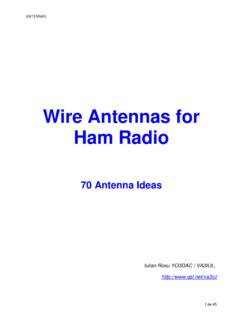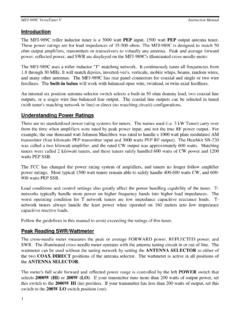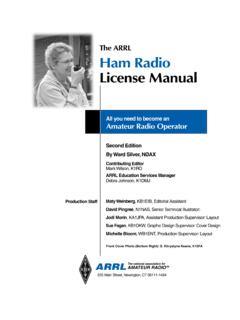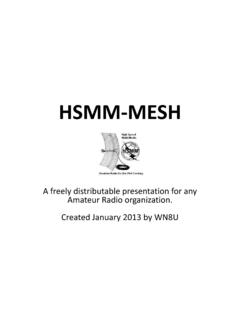Transcription of HF Antennas for Beginners – 30 Meters and Below
1 1 HF Antennas for Beginners 30 Meters and Below Gary Wescom N0GW January 2, 2007 For a ham who is new to HF operation, there is a number of new things to learn. Among them are the propagation characteristics of the various ham bands, the correct operation of their radio gear, and what to do about Antennas . This article will focus on that last item. Why a discussion on Antennas is appropriate is simply that new HF operators don t yet know how critical the subject is. There is a lot to think about when starting out. Setting up proper Antennas often slips to the bottom of the priority list. After a few years of experience, that would never be the case. The next time you hear one of those 40 dB over S9 signals, think about this: he may be running a kilowatt output to his antenna but if he turns his amplifier off and drops back to 100 watts, he will still be 30 dB over S9. How do these big gun guys do it? Simple, they put up good, efficient Antennas .
2 These are not huge installations. Most of these signals are coming from simple dipole Antennas . It is the care and thought put into their installation that makes the difference. The subject of Antennas is a source of great confusion. There is a tremendous amount of information available on the subject. Some of which is accurate, some not so. Adding to that confusion are the performance claims made by commercial antenna manufacturers in their advertisements. One company even claims their 3 foot tall product will out perform a full size 65 foot tall vertical on 80 Meters . That claim, of course, is false. So where is a fellow to start? With the basics of course! Those are fairly simple: 1. Full size Antennas work better than smaller Antennas . Full size Antennas typically offer higher efficiency and wider operating bandwidth. 2. Higher Antennas work better than lower Antennas . That is true up to about 50 or 60 feet for most operation. The effect at greater heights varies from band to band and the distance to the station you wish to talk to.
3 3. Antenna gain depends upon efficiency and directivity. An efficient antenna can only achieve gain in one direction by reducing the signal strength in another. An inefficient antenna cannot be counted on to have any useful gain in any direction. 4. There is no single best antenna. What works best varies from band to band and from location to location. For folks just starting out, those are not often the most pleasant things to read. They say you need to put up something big and high if you want to operate HF. These rules can be ignored but only when the consequences are understood. It can be very frustrating for HF Antennas for HF Beginners 30 Meters and Below 2 Beginners when their expectations for HF operations are not met because of an inadequate antenna system. What kind of antenna should you install? What kind of antenna should you put up? Obviously that depends upon a number of site specific factors including how much room you have for installing Antennas and how tolerant your wife and neighbors are.
4 Oh yes, and how much money you are willing to spend. The sky is really is the limit when it comes to antenna systems. It is probably best for an HF newcomer to start out modestly. Simple wire Antennas work well on the 10 Mhz band and Below . Ground mounted vertical Antennas are also useable on these bands though they do require more effort during installation to obtain good performance. Concentrate first on achieving adequate performance with the simpler Antennas before attempting more complex systems. What kinds of Antennas should the newcomer avoid? First off, avoid the shortened all-band Antennas . Horizontal Antennas less than a quarter wavelength long and verticals less than an eighth wavelength high are inefficient, narrow banded, or both. They can be made to work but usually not by a HF beginner. The problem with the shortened all-band Antennas is that they look good in magazine ads. The idea of a small, easily installed, do everything antenna is seductive.
5 It can seem like the answer to a new HF ham s dreams. Unfortunately achieving the performance claimed in the magazine ads is possible only under special conditions. It is unlikely that those conditions can be met in an average backyard installation. The Safest Bet A Dipole or Inverted Vee The safest bet for an antenna system for the bands Below 20 Meters is a simple half wave dipole. It should be resonant on the desired operating frequency, have a balun at its feed point, and be fed with RG-213 coax. Why a dipole? That is simple, it is among the most efficient Antennas that can be built, its performance and directivity are well known, and it is so simple that it is nearly foolproof. Why an Inverted Vee? It is really just a dipole with its ends drooping down a bit. I ll explain more about the differences later. Dipole wire Let s discuss some of the dipole construction basics. It should be built with copper or aluminum wire, copper being the most common.
6 The wire may be solid or stranded. It need not be bare wire. Antennas have traditionally been built with bare wires. That was the case because in the early half of the 20th century, wire insulation did not survive very well out in the weather. Modern insulation is much tougher. Use of insulated wire has become more common because of availability and reduced rain static. HF Antennas for HF Beginners 30 Meters and Below 3 Wire diameter is not critical but 12 and 14 seem to be the most common. Thinner wire is more fragile. Thicker wire provides wider operating bandwidth. Experienced HF operators will use thicker dipole conductors. It is not unusual for 80 meter dipoles to be made with old used RG-213 size coaxial cable. The shield and center conductor are tied together and treated as a large diameter conductor. The coax, with its plastic dielectric, is much lighter than copper wire of the same outer diameter. The coax jacket provides rain static reduction.
7 The larger diameter provides a broad low SWR bandwidth with a high efficiency. Balun Though not required, it is best that a balun be used at the dipole feed point. Its purpose is to disconnect the shield of the feedline from the antenna. Without the balun, the coax shield is directly connected to one side of the dipole and thus is part of the antenna. Signals and noise picked up by the coax shield are heard in the receiver. They may not be the things you are intending to hear. Likewise, part of the transmitted RF is fed back down from the feed point along the coax shield and can interfere with equipment in your house. Some folks claim the coax shield radiation and pickup fills in any gaps in the dipole s radiation pattern. There is really no reason to expect this effect to be all that helpful. There have been many instances where it has cause noise and RFI problems. Feedline With coaxial cable, size matters. Some RF is always lost as it runs through coax.
8 There is resistive loss from the RF current in the coax conductors. There is dielectric loss from the RF voltage between the coax center conductor and its shield. The thicker the coax, the lower these losses are. RG-58 50 ft. RG-8X 75 ft. RG-213 100 ft. RG-8 Foam 200 ft. The above table provides a rough approximation of recommended maximum lengths of the various kinds of coax hams typically use for HF operation. There are lower loss but more expensive kinds of coax available for even longer runs. Generally speaking though, exceeding the above listed lengths by a factor of two is OK as long as it is understood that coax feedline loss will be around 3 dB on the 10 and 12 meter bands. Each kind of coax has a power limit that is determined by heating and voltage breakdown limits. RG-58 and RG-8X should be used at power levels less than about 500 watts. RG-58 can overheat. RG-8X s foam dielectric has a low breakdown voltage. RG-213 and other coax of the inch diameter easily handle the full 1500 watt legal ham power limit.
9 HF Antennas for HF Beginners 30 Meters and Below 4 Building a dipole Dipole construction is simple. Two quarter-wave wires are connected to each side of the balun or center insulator. Insulated support ropes or wires are attached to the ends of the wires. Most dipoles are installed with center support for the balun or center insulator. That simplifies installation since only one tall support is needed. The weight of the feedline is carried by the center support, not by tension on the the dipole elements. The element ends are simply pulled outward to convenient tie off points. When the element ends angle down more than a few degrees, the antenna is known as an Inverted Vee. The connections between the feedline and the antenna wires must be both electrically and mechanically solid. A problem to solve is how to achieve this while allowing for the flexing that will no doubt occur from wind blowing the dipole elements around. Another big problem to solve is sealing the end of the coax cable to keep rainwater out.
10 Any moisture that gets into coax will corrode conductors and contaminate the dielectric, increasing power loss and the reducing breakdown voltage. As a general rule, insulators should be used at the outer ends of the dipole wires. High RF voltages occur at the ends of the dipole wires. When synthetic material string or rope is used, however, the support material itself is often sufficient insulation. Installing a dipole Dipole installation is straightforward. Connect the antenna wires and the feedline to the balun or center insulator. Waterproof the connections. Raise the balun or center conductor to operating height, preferably pulling it with a lanyard running through a pulley or eyebolt. Pull the ends of the antenna wires outward and temporarily attach their ropes to your predetermined tie-off points. I say temporarily advisedly. Hanging a dipole is only the first step of installation. The next part is to carefully adjust the wire lengths to resonate the dipole at some desired frequency.











